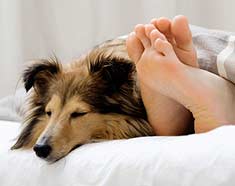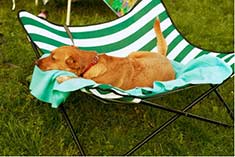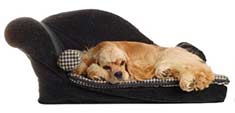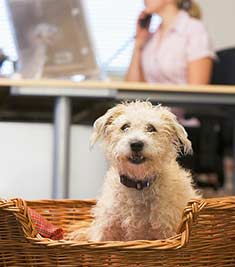How Do I Choose a Bed for My Dog?

Let’s face it, we all know your dog will prefer your bed or couch to anything you spend money on specifically for him, but if you choose a bed to meet his needs, you may just be able to convince him to use it. Consider his preferred sleep style, his size, his special needs, and whether or not he will be in a crate before you decide on the type of bed in which to make your investment.
Sleep Styles
Remember that your dog will likely spend an average of 14 hours each day sleeping, so you want to make sure he is comfortable. By spending a little time observing your dog during those 14 hours, you will be able to determine his sleep style preference, which will guide you as you begin looking at beds.
Most dogs will seem to prefer one of four styles:
- Enclosed in a small space
- Supported so they can lean against something
- Sprawled out, taking up as much surface area as possible
- Burrowed under a cover
Dogs who like enclosed spaces
If, given his druthers, your dog finds the smallest place possible in which to sleep, he may prefer to sleep in his crate, with simply a small pillow or even an old towel to keep him warm. If you won’t be crating your dog most of the time, he probably will feel most comfortable with a bed that has a raised edge on all four sides. You may see these advertised as “bumper beds” in stores or online. You might also consider some of the designer beds such as those that look like canopy beds or hammocks, both of which will give your dog that sheltered feeling he likes.

Dogs who like to be supported
If your dog likes to sleep on the couch, leaning against the arms or the back, he might like a bed that is shaped like a chaise lounge. I’m not talking about the beach chair kind of chaise, but rather the kind you see at the end of a bed in a large, upscale bedroom. In addition, some dog beds are even shaped like an actual couch, which may be just up your dog’s alley. The key here is to provide something he can curl up against, or possibly even place his head on top of. There are also beds that have bolsters along one or more sides, or your dog may be happy to simply rest his head on a pillow.
Dog beds for sprawlers

Sprawlers may appreciate a large pillow or mat, or they may prefer to simply stretch out wherever they plop down. These are the most annoying dogs to have in your bed with you because they take up the entire bed and refuse to move. You might encourage your dog to move to his own space by putting a treat on his bed or playing with him for a bit near his bed, then placing the toy on his bed. Make sure you buy a bed that is big enough for him to fully sprawl out.
Beds for burrowing dogs
The perfect bed for burrowers is marketed under the brand name of Cosy Cave. This bed has a pocket which allows the dog to go under the top layer of the bed. The bottom layer is a thick mattress, while the top layer is more like a heavy blanket.
What about older dogs?
As your dog ages, he may begin to develop joint problems that make it difficult for him to sleep. Orthopedic dog beds help to distribute the dog’s weight and take some of the burden off of his joints. They are even making dog beds with memory foam. These beds conform to your dog’s curves, providing support for all parts of the body. (Remember the commercial where they jump on the mattress and the wine glass doesn’t tip over?)
In addition, heaters are available to keep the dog’s joints warm throughout the night. If the bed itself is not heated, you might purchase a heating pad that goes into your microwave to provide warmth. Never put a heating pad directly under your dog! He can be burned or may chew into it, causing electrocution.
To heat or not to heat?
Other than with elderly dogs, the decision about heating your dog’s bed is pretty much a personal choice. Consideration should be given to the type of fur your dog has. Long-haired dogs are much better able to keep themselves warm than are short-haired dogs. Think about how warm you keep your home during the winter. Do you turn down your thermostat to save energy? Do you sleep with the window open? Do you crank up the heat for your small children?
Observation of your dog can also guide you on this question. Dogs who tend to curl up or burrow may be doing so simply because they are a bit chilly, and they may benefit from a heated bed. Dogs who stretch out or pant all night may not appreciate the extra heat.
Conversely, there are beds that come with cooling pads to help your dog beat the heat during those dog days of summer.
What’s the best material for a dog bed?

The materials you choose for your dog’s bed really depend on your lifestyle and where the bed will be used. For example, if you are taking your dog camping, you may want to choose a heavy-duty cover with cedar chips inside. The oil in the cedar is a great insect repellant and can keep the bed smelling fresh even after your dog has romped through a stream or rolled in something fragrant.
Another good choice for outdoors is a nylon cot. It keeps your dog up off the ground and is easily hosed off when your dog lies down after rolling in mud or anything else. This is one of the most frequent applications where cooling pads are used.
Beds or mats made from fleece or corduroy may provide a good way to keep your dog warm without driving up your electric bill with a heated bed. These beds are made from synthetics which are easily machine washed and dried.
Sheepskin beds are a bit harder to clean, typically needing to be hand-washed. However, they provide warmth in the winter while staying cool in the summer.

Designer beds
For the truly pampered pooch, you may want to look at designer beds. With choices ranging from a “Sugarplum Princess Tent” to a Papasan chair to cabanas to beds covered in exotic prints, you are sure to find a bed that measures up to your dog’s discriminating tastes!
How many dog beds does one dog need?
The minimum number of beds you could have is obviously zero. If you don’t mind having no room in bed and no un-furry places to sit in your house, then you don’t need a bed for your dog at all.
However, if you want to protect your furniture and preserve your bed space for you, you might consider providing your dog with his own sleeping place. Your dog will naturally want to be near you and the family, so consider buying a bed for the room(s) where you spend the most time. Obviously, one will go in your bedroom. You may also want one in the kitchen, den, family room, and / or rec room, so your dog can settle down in comfort but still be part of the action. Some families also place dog beds outside if they spend a lot of time in the yard. This can be helpful in keeping your dog from dragging leaves, mud, and bugs into your home by keeping him from lying on the ground.
With so many styles and colors to choose from, there’s no reason you can’t find one to match any décor. The online store iDogBeds has a huge selection of all types of dog beds as well as a page of helpful information to help you choose the right bed for your dog.
Doggies Den: Latest Articles
 Homemade Thanksgiving Treats for Your Dog
Homemade Thanksgiving Treats for Your Dog
NUTRITION We all want to include our dogs in our holiday celebrations, but hopefully, you're aware that sharing table scraps with your dog isn't always the best idea.
 Keeping Your Dog Safe during the Summer Months
Keeping Your Dog Safe during the Summer Months
HEALTH Summer is coming on fast, so it’s time to plan how you will keep your dog safe and healthy through the lazy, carefree, warm days.
 Vaccination Time Again-Keeping Your Puppy Healthy
Vaccination Time Again-Keeping Your Puppy Healthy
DOG HEALTH So you have your new puppy picked out. There are quite a few shots, treatments and examinations that will keep the newest member of your family healthy.
 Canine Thanksgiving Feast
Canine Thanksgiving Feast
NUTRITION With the wide variety of food at Thanksgiving dinner, chances are you'll want to give your dog something special, too. If you're contemplating what to feed your dog for the holiday, here is a guide to a great Canine Thanksgiving Feast.
 Dog Walking Tips Every Owner Should Know
Dog Walking Tips Every Owner Should Know
DOG FUN Walking your dog is not only crucial to keeping him healthy and happy, it strengthens the bond between your canine friend and his caregiver. There are a lot of obstacles out there. Don’t forget these simple tips to keep your walk fun and safe in the outside world.
 The Benefits of Physiotherapy for your Dog
The Benefits of Physiotherapy for your Dog
HEALTH The same techniques that physiotherapists use to treat a variety of injuries and conditions in humans have been adapted to suit animals with great success. Family pets, show dogs, and working dogs can all benefit greatly from physiotherapy. Dogs whose activities involve a lot of agility are especially susceptible to the types of problems that physiotherapy can address.
 The Decision- Adding a Dog to Your Family
The Decision- Adding a Dog to Your Family
FIRST TIME OWNERSBringing a dog into your family is a decision where many people don’t realize it’s magnitude until after they have the dog. There are a number of things that you need to research before you decide to purchase a dog, and it starts right in your own home.
 Bringing Your Dog Into Your New Baby's Life
Bringing Your Dog Into Your New Baby's Life
HEALTH Many believe that a dog and a new baby cannot happily coexist, so therefore the dog has to go. This is not necessarily the case.  A new baby does not mean you have to abandon your dog.

Doggies Den:
Most Popular Articles

Dog Pregnancy Symptoms
HEALTHIf you suspect your dog might be pregnant, check out part one in this series on pregnant dogs, where we cover pregnant dog symptoms.

Dog Birth
HEALTHIn the third article of our dog pregnancy series, we look at the wonderful, but messy, process of bringing newborn puppies into the world.

Indoor Dog Potties
DOG PRODUCTSIt's been a long day at work. You were so busy, you didn't even take time to eat a sandwich, let alone run home to let your dog out. You're on your way home, knowing the poor dog is crossing his or her legs by now, when your car breaks down, delaying you even further. Can't somebody make this easier?

Your Dog’s Digestive System
PHYSIOLOGYEver wonder why your dog eats so fast? Or why he eats gross things? Or why he gets sick to his stomach? Or why his waste stinks so bad? Some of these things are normal, some are not.

Canine Respiratory System
BREATHINGThe basic function of your dog's respiratory system is to bring oxygen in to and remove carbon dioxide from the body. Knowing the symptoms of respiratory diseases can help you help your stay healthy.

Shelter Dog Adoption Tips for Success
ADOPTION Are you intimidated by the prospect of "rescuing" a dog from a shelter? One reason that you may be wary of adopting a dog from a shelter is not knowing how to choose. Adopting a dog from a shelter can be a rewarding process, if you're prepared to do a reasonable amount of research.

Canine Urinary Tract Infections
SYMPTOMS AND TREATMENTDoes your dog seem to be having trouble relieving his or her bladder? Learn how to recognize the signs of urinary tract infections and how to treat them before they spread.

What to do for Dog Diarrhea
SYMPTOMS AND REMEDIESIf you have dogs in your house for any length of time, you have likely experienced at least one bout of dog diarrhea. Beyond the pain in the tuckus involved in cleaning up the mess, you should know what causes diarrhea, and when it's important to see the vet.

What to do for a Dog Bite
DOG BEHAVIOR Getting bitten by a dog can be scary, and you may be tempted to run around in circles for a while, trying to figure out what to do. Here's our guide to help you manage the situation.

Top Ten Tips for Living with a Senior Dog
DOG HEALTH Bringing home a new puppy is so exciting, but it doesn’t take all that long for your exuberant puppy to grow into a senior dog who may have special needs. Here are the doggies.com top ten tips for taking care of your companion who has been with you through so much.
